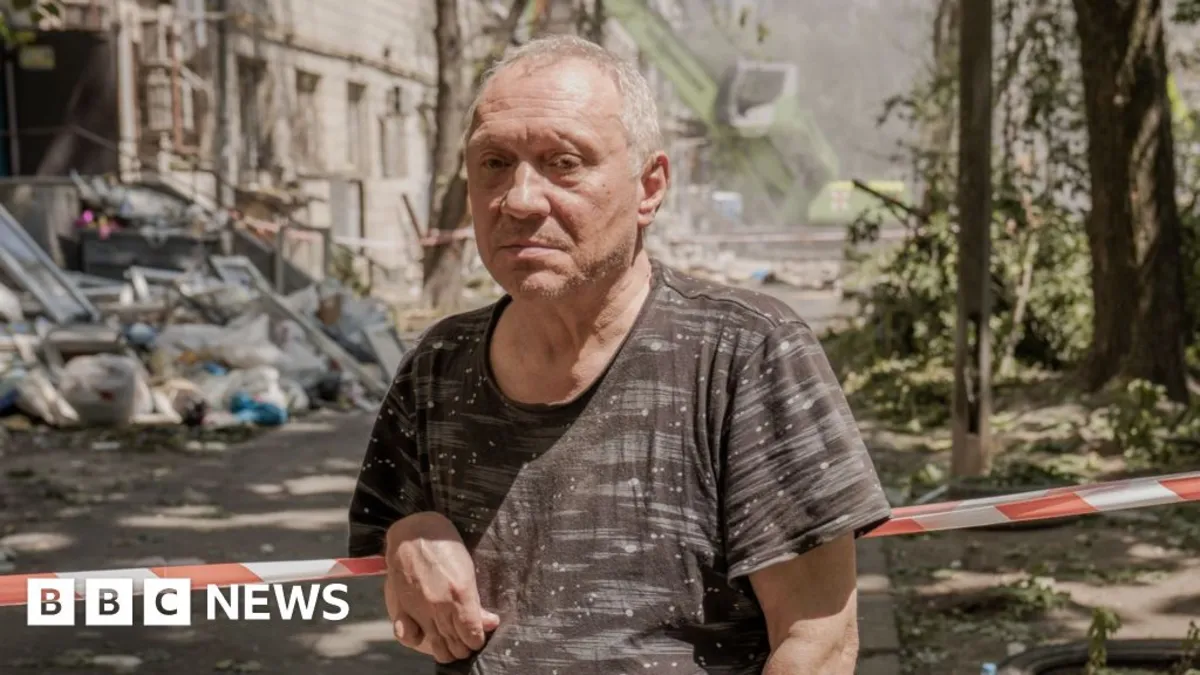
In the early hours of Tuesday morning, a devastating airstrike transformed a peaceful residential area in the Solomianskyi neighborhood of Kyiv. Evhen Povarenkov stood anxiously behind police tape as he gazed at the remnants of his apartment building. The destruction was catastrophic; windows were obliterated, and his balcony teetered on the brink of collapse. Personal belongings were scattered across the ground, with bedsheets and towels hanging from branches like ghostly reminders of normalcy. A cruise missile, likely traveling at speeds of approximately 500 mph, struck the building, annihilating 35 apartments and carving a gaping hole in the structure.
By Wednesday afternoon, the grim reality set in as rescue teams uncovered 23 bodies from the rubble, contributing to a total of at least 30 fatalities across Ukraine, the majority of which occurred in Kyiv. This assault was part of a larger, coordinated attack by Russia, involving over 440 drones and 32 missiles, according to reports from Ukraine’s air force. The barrage pounded Kyiv for nine relentless hours, marking one of the most severe attacks since the onset of the full-scale invasion.
Povarenkov, a 43-year-old warehouse worker, recounted the harrowing moment the missile struck. He was in bed, while his elderly mother rested in the next room. “There was heat, fire, and smoke,” he recalled. “I lost consciousness. When I came to, I heard my mother screaming.” With the help of neighbors, Povarenkov managed to free himself and his mother from their devastated apartment. The chaos outside was overwhelming, with people screaming and children crying, as described by Arcadiy Volenchuk, a 60-year-old pensioner.
“Everything was on fire,” said Alla, a 69-year-old teacher. “The fuel tanks in the cars were exploding. Broken glass and debris were raining down.” Povarenkov’s mother suffered severe injuries, including two broken collarbones and damage to her internal organs, necessitating immediate surgery. She was among more than 100 individuals wounded in the city as a result of the attacks.
As the strikes began, Serhii Dubrov, an anesthesiologist and director at the 12th Kyiv City Clinical Hospital, prepared for an influx of casualties. His hospital received 27 patients within hours, many suffering from serious injuries such as lacerations, traumatic brain injuries, and internal chest injuries. “The worst was a woman with an open head injury,” Dr. Dubrov noted, emphasizing the severity of the wounds inflicted by such indiscriminate violence.
Among the injured were individuals ranging from 18 to 95 years old, illustrating the indiscriminate nature of the attack. Elderly residents, like 64-year-old Oleksandr Bondarchuk, found it particularly difficult to reach safety. Bondarchuk, who was unable to make it to the shelter, described the terrifying experience: “It was terrible. Everything was destroyed.” Although some survivors sought refuge with friends or family, many were left to grapple with the aftermath alone.
The missile strikes coincided with Ukrainian President Volodymyr Zelensky’s visit to the G7 conference in Canada, raising suspicions that Russia's timing was a calculated move to send a brutal message. This large-scale attack highlighted Ukraine’s urgent need for enhanced international support and air defense systems. However, Zelensky's diplomatic efforts were thwarted as his anticipated meeting with U.S. President Donald Trump fell apart amid escalating tensions in the Middle East.
As Zelensky returned to Ukraine, the community in the Solomianskyi neighborhood came together to mourn. Residents gathered to lay flowers at the site of the missile attack, paying tribute to those lost. Meanwhile, Evhen Povarenkov remained behind the police tape, unable to retrieve his and his mother’s belongings, as emergency workers continued to search the rubble for more victims.
This tragic event serves as a stark reminder of the ongoing conflict in Ukraine and the devastating impact it has on innocent lives.